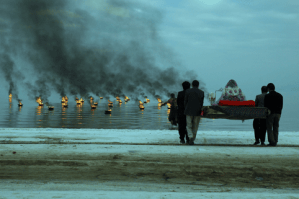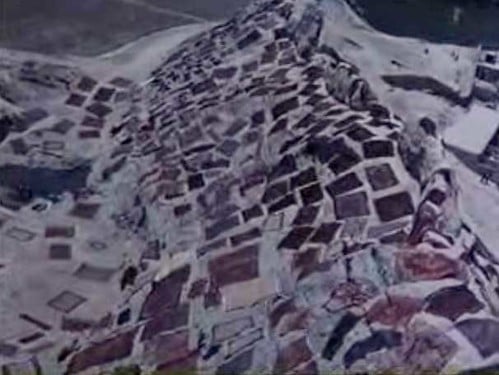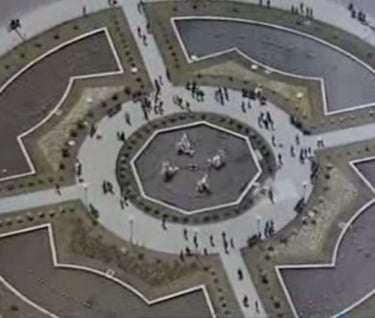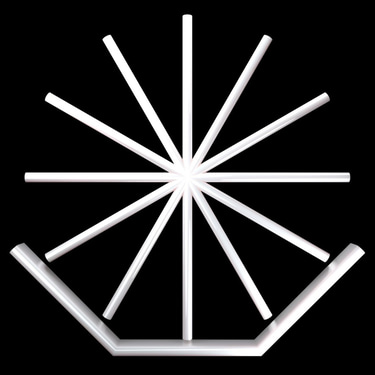Iran in L.A.
Christine Haroutounian
3/5/2011
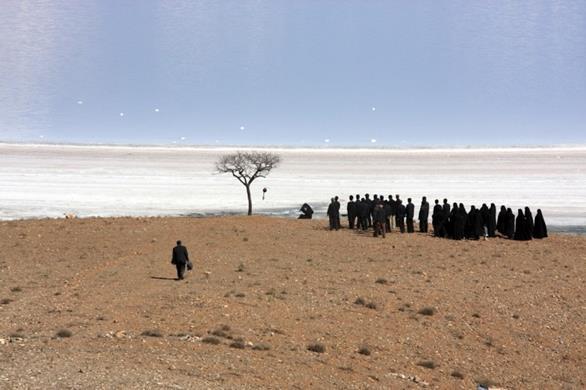

The UCLA Film & Television Archive recently finished its month-long celebration of Iranian Cinema and I was lucky to view some of the rare footage made available to curious audiences who filled the Billy Wilder Theatre at the Hammer Museum. I often found myself overwhelmed by a range of emotions, from anger, shock, and confusion to wonder, delight, and hopefulness, thanks to the amazing variety of films coming out of Iran both today and in the past.
Of the more serious films that come to mind, We are Half of Iran’s Population is a stunning documentary that explores the plight of the modern woman in Iran, still suffering from primitive laws and crippling prejudice in a patriarchal culture. It begins with a montage of various women, from intellectuals, lawyers, writers, mothers, to journalists (all victims alike), and through rapid cuts, organizes all of their concerns in a dramatic, arresting fashion. Within a few minutes, one sees dozens of veiled faces and hears a variation of tone conveying fury, weakness, optimism, and sheer desperation. Despite presenting a plethora of dire social issues, one message ultimately rings clear: change is critical. Although I was very touched by the horrifying stories the women shared on screen, director Rakhshan Bani-Etemad’s decision to balance this emotional onslaught by exploring and offering plausible solutions to the status of female Iranian citizens was sobering, and provided a necessary break to think lucidly about the situation. One of the most compelling parts of the entire documentary was that the candidates of the last election, Mehdi Karrubi, Mir Hossein Mousavi, and Mohsen Rezaei and their wives (Ahmadinejad was invited but declined), were filmed watching what we as an audience were viewing as well. They were questioned, their opinions were heard, and their solutions were offered, which provided me with a minor sense of comfort knowing that they got the chance to learn as much as I did that night, and that they could possibly apply that knowledge to reform Iran’s unfair politics against women. We are Half of Iran’s Population not only captures the emotions of the audience but also highlights the urgency of educating people about the silenced voice of an entire demographic.
Another unforgettable film was Mohammad Rasoulof’s The White Meadows, which
hauntingly follows a man who collects the tears of suffering people to purify their souls from sin.
When Rasoulof’s and Jafar Panahi’s names appeared during the opening credits, an appreciative
applause erupted from the tense yet excited audience, who clearly knew that the film’s striking
imagery is more than just a cinematic treasure but a grave political message of Iran today. The
cinematography and compositions of every single scene reminded me of Parajanov’s The Color of
Pomegranates with its nonlinear plot, pictorially driven by potent symbolism. Rasoulof’s pace is
quite slow, and that is expected of a film that studies the misery of human existence. This is
translated through the various episodes in which we meet an artist who is nearly blinded and exiled
because of his artistic decisions, a virgin bride who is sacrificed to the sea for the supposed good
fortune of backward villagers, and a man left to die in a well full of everyone’s secrets; the brutality
of life is also depicted through harsh landscapes of salt islands and the eerie lifelessness of Lake
Urmia. The White Meadows seems to critique man as a wrinkle in time within the history of earth,
and that our lives are too petty to accept without blind belief in superstitions and higher powers.
Yet again, it is a grim catalogue of the terrifying consequences of ignorance as one repetitively
witnesses the film’s rare, creative, and youthful characters challenge the rigid, illogical views of the
masses and suffer for holding differing perspectives, much like the fate of the director and editor of
the film.
Shying away from heavy politics, The Lovers’ Wind by Albert Lamorisse pays homage to Iran’s everlasting beauty. It was very refreshing to see a film that was not directly related to unyielding political turmoil (although it was commissioned by the last Shah) but rather reminded me of a country whose ancient civilization and picturesque lands once played highly influential, positive roles in the world – a far cry from what Iran seems today in popular memory with fundamentalist leaders and hyperbolic media coverage. The film’s narrator maneuvers between personifying nature and scientifically explaining what certain things, such as particular wind gusts, are called by local inhabitants, giving the regal imagery an added quirky yet romantic quality. The documentary made me nostalgic of a place I’ve never visited before but have only heard of through anecdotes of family members who lived there prior to the Revolution. Viewing the intricate farm patches, geological carvings, and turquoise and beige lake waters, I couldn’t help but think of Gustav Klimt’s paintings. The land itself was identical to the multilayered, splendid textures of Klimt’s usage of material and the dizzying patterns of his models’ clothing and thick hair. Modernist architecture and urban lifestyles are juxtaposed with ruins of the ancient civilizations and huts in lush green areas, showing Iran’s rich past and its great achievements, and its potential to grow furthermore.
Sadly, Lamorisse died during the filming of this documentary, and knowing that somewhat veiled my experience: watching something so grand with the knowledge that it would end so abruptly and painfully (like the Shah’s rule) made me feel sadness for what Iran largely represents today.
